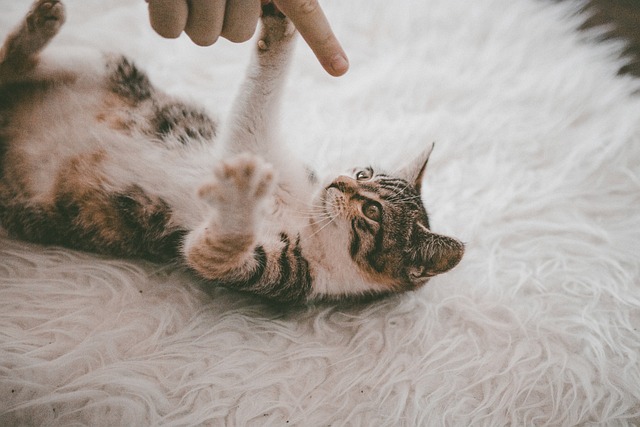Pet stains on carpets require understanding stain types and causes. Act swiftly by blotting, identifying stain type, and using appropriate cleaning solutions (vinegar/detergent for urine or solid matter). Prevent stains through regular vacuuming, entry mat use, and good pet hygiene. Use natural methods like baking soda/vinegar or hydrogen peroxide, testing first on hidden areas. A meticulous process involving blotting, cleaning agents, and rinsing removes stains. Proactive maintenance with regular vacuuming, spot cleaning, and stain-resistant treatments keeps carpets clean.
Carpet pet stain treatment is a necessary aspect of maintaining a clean and inviting home. Understanding the causes behind these stains and knowing how to address them promptly can significantly extend your carpet’s lifespan. This article guides you through the process, from immediate action after a spill to effective cleaning solutions and step-by-step removal techniques for various types of pet stains. We also offer maintenance tips to help keep your carpets spotless long after treatment. Discover practical strategies on how to remove pet stains from carpets and restore your floors to their original condition.
Understanding Pet Stains on Carpets

Pet stains on carpets can be a common and frustrating issue for many homeowners. Understanding the nature of these stains is the first step in effective removal. Different types of pets, from cats to dogs, produce unique marking materials—urine, feces, or even paw prints—that require specific treatment methods. For example, urine stains often leave a pungent odor and may cause the carpet fibers to break down over time if not addressed promptly. Fecal matter can be particularly challenging due to its sticky consistency, which can make thorough cleaning more difficult.
Knowing how to identify these stains early is key to successful treatment. Regular vacuuming helps remove surface debris, but for deep-set stains, a combination of blotting, using specialized cleaning solutions, and sometimes enzymatic treatments might be necessary. Blotting absorbs excess liquid, preventing it from seeping deeper into the carpet fibers. How to remove pet stains from carpet effectively involves targeting the stain at its source, whether that’s an accident or regular pet behavior, and choosing the right tools and products for the job.
Immediate Action: What to Do Right After a Stain Occurs

When it comes to pet stains on your carpet, acting quickly is key. The moment a spill or accident occurs, don’t delay; jump into action! Blotting is the first step in how to remove pet stains from carpet effectively. Using clean, white cloths, gently press down on the stain to absorb as much of the liquid or solid as possible. Avoid rubbing, which can spread the stain further.
After blotting, identify the type of stain and choose an appropriate cleaning solution. For urine stains, a mixture of equal parts water and white vinegar is often effective. For solid matter like feces, opt for a mild detergent or a carpet-specific cleaner. Apply the chosen solution directly to the stain, work it in gently, and allow it to sit for a few minutes before thoroughly rinsing with warm water and re-blotting if needed.
Common Causes of Pet Stains and How to Prevent Them

Pet stains on carpets are a common issue for many homeowners, but understanding their causes can help with effective prevention and treatment. Accidental spills and messes are inevitable, especially with curious pets roaming around. Common culprits include urine, feces, food particles, and grooming debris like fur and dander. These substances can quickly stain carpets if not cleaned up promptly.
To prevent pet stains, regular cleaning and maintenance are key. Regular vacuuming helps remove loose hair, dander, and soil before they settle into the carpet fibers. Using pet-friendly floor mats at entryways can trap dirt and moisture from outdoor activities. Additionally, encouraging good pet hygiene practices, like regular bathing and brushing, reduces the amount of loose fur and dander that might land on carpets. Promptly cleaning up any accidents with specialized pet stain removers or warm water and a mild detergent can prevent deep-set stains.
Effective Cleaning Solutions for Carpet Pet Stains

When it comes to effective cleaning solutions for carpet pet stains, there are several DIY options that can help restore your floors to their pristine condition. One popular and natural method involves using baking soda and vinegar. Start by sprinkling a generous amount of baking soda over the stained area, letting it sit for about 15 minutes. Then, gently blot the stain with a clean, slightly damp cloth or sponge, working from the outside in to prevent spreading. Next, mix equal parts white vinegar and warm water, and apply this solution to the treated spot. Allow it to bubble and lift the stain before rinsing thoroughly with cold water.
Another powerful cleaning agent is hydrogen peroxide, which can be used undiluted for fresh spills or mixed with a mild detergent for more stubborn stains. Apply the solution directly to the carpet fiber, let it sit for several minutes, then blot dry using a clean towel. For older, set-in stains, consider using enzyme-based pet stain removers that break down the organic matter responsible for the discoloration. Always test any cleaning solution on a small, hidden area of your carpet first to ensure it doesn’t cause any adverse reactions or color fading.
Step-by-Step Guide: Removing Various Types of Pet Stains

Removing pet stains from carpets requires a step-by-step approach tailored to different stain types. Start by blotting the surface to absorb as much liquid as possible. For urine or fecal stains, use a clean cloth soaked in cold water to blot gently, avoiding rubbing which can spread the stain.
Next, apply a suitable cleaning agent. White vinegar and baking soda are natural options effective for most stains. For tougher cases, use a commercial carpet cleaner or a mixture of warm water and mild detergent. Gently rub the solution into the fiber using a soft-bristled brush. Rinse thoroughly with clean, cold water and blot dry to prevent residual moisture from setting further stains.
Maintenance Tips for Keeping Carpets Spotless Post-Staining

After successfully treating pet stains on carpets, maintaining a clean and stain-free environment is key. Regular vacuuming is essential to prevent dirt and debris from settling into fibers, which can lead to new stains. Focus on high-traffic areas and corners where pets often gather. Additionally, spot-cleaning immediately when an accident occurs can significantly reduce the risk of permanent staining.
Consider using carpet cleaners or stain-resistant treatments regularly to create a protective barrier. These measures will not only keep carpets looking fresh but also make future stain removal easier. Remember, consistent care and prompt action are your allies in the battle against pet stains on carpets, ensuring a clean and comfortable home environment for both you and your furry friends.
